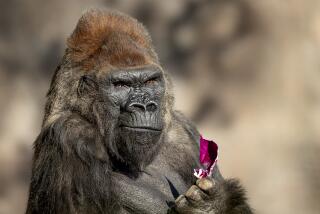Probe Foretells Future of Gorilla Habitat
- Share via
RUHENGERI, Rwanda — Data gathered by a 200-pound remote sensor could provide clues on how to deal with the dilemma of accommodating Rwanda’s burgeoning population and several hundred rare mountain gorillas.
Dubbed PROBE-1, the sensor flew in a twin-engine Cessna over the green-shrouded dormant and extinct volcanoes of northwestern Rwanda where the gorillas roam, recording reams of environmental data so detailed that it has filled 22 CD-Roms. Researchers hope the information will help them to better understand the habits, the coping mechanisms and the threat to Rwanda’s remaining 310 mountain gorillas from encroaching human settlement.
The probe, a “hyperspectral sensing instrument,” successfully scanned the 10 varieties of bamboo eaten by the gorillas in the three sweeps it made during a week last September, reading 128 bands of light, or wavelengths, instead of the normal three picked up by orbiting satellites, said Dr. Liz Williamson, director of the Karisoke Research Center.
Although gorilla conservationists have yet to study all the data the flight produced, scientists who have seen the results were impressed.
“The images we have analyzed so far reveal an unprecedented degree of detail in the vegetation in the gorillas’ habitat,” said Larry Lass, a University of Idaho scientist who completed preliminary processing of the imagery. “Preliminary interpretations . . . indicate the relative abundance and distribution of the gorillas’ principal foods in the Virunga Mountains.”
The Karisoke Research Center was set up by the late Dian Fossey, who spent 18 years studying Rwanda’s mountain gorillas before she was murdered in 1985. The center is run by the Dian Fossey Gorilla Fund International.
Conservationists have combined the latest technology of the satellite-based global positioning system, wireless communication and the geographic information system --as Probe 1 is formally known--to learn more about the gorillas’ chances of survival.
The world’s 620 remaining gorillas live in the volcanic mountains between Rwanda, Congo and Uganda, where they are under constant threat of civil conflict, poaching and human settlement.
The 1994 genocide in Rwanda that took the lives of more than 500,000 people, most of them minority Tutsis, and the subsequent attacks by Hutu rebels of the former Rwandan army forced Volcanoes National Park to close to visitors and researchers from June 1997 to July 1999, when it reopened.
When Fossey was conducting her research, she used a camera, binoculars and field journals. Today the cutting-edge technology will provide data that until very recently would have taken months or years to gather and ages to study.
The probe was developed by the McCall, Idaho-based Earth Search Sciences Inc., one of whose owners is media mogul Ted Turner. ESSI made a one-time loan of the probe to the Georgia Institute of Technology, which has created a virtual, 3D simulation of Volcanoes National Park on its Atlanta campus, where scientists will decode the data in July.
“The carrying capacity of the park can be assessed by examining how much vegetation exists of the type the gorillas eat,” said Nicholas Faust, a Georgia Tech researcher.
“Based on that, scientists can determine how many gorillas can be sustained. This would provide the local authorities with information that would help them manage the habitat over a period of time by looking at how it is changing.”
In their lairs in the lush volcanic foothills, most of the gorillas appear to have come through Rwanda’s decade of wars and insecurity unscathed. Half a dozen babies have been born.
But a new threat looms in the form of a government plan to resettle 500 families--landless Tutsi farmers who survived Hutu-orchestrated massacres--on land that is inside Volcanoes National Park.
Officials working on the plan say they were led to believe the land was outside the park, which covers 5% of Rwanda’s 10,169 square miles.
Population pressure has already reduced the park, which opened in the 1920s under Belgian administration as the first in Africa, to 46% of its original size.
With an estimated 7.2 million people and an annual population growth rate of 3%, Rwanda is one of the world’s most densely populated countries. An average 300 people live on a square kilometer, and the figure is double that in northwestern Rwanda where the park is located.
Since 1994, the government has allocated a large portion of the eastern Akagera National Park to people returning from decades in exile in neighboring countries.
“Removal of natural forest destroys gorilla habitat, and regeneration of the delicate vegetation at such high altitudes is especially slow,” Williamson said.
Supported by the latest data, she said she expected the government to abandon its resettlement plan in Volcanoes National Park and instead strengthen the gorilla sanctuary that brought in $1 million in 1989 when a record 7,000 people viewed the apes.
On the Net:
Earth Search Sciences:
https://www.earthsearch.com
Dian Fossey Gorilla Fund:
https://www.gorillafund.org
More to Read
Sign up for Essential California
The most important California stories and recommendations in your inbox every morning.
You may occasionally receive promotional content from the Los Angeles Times.













